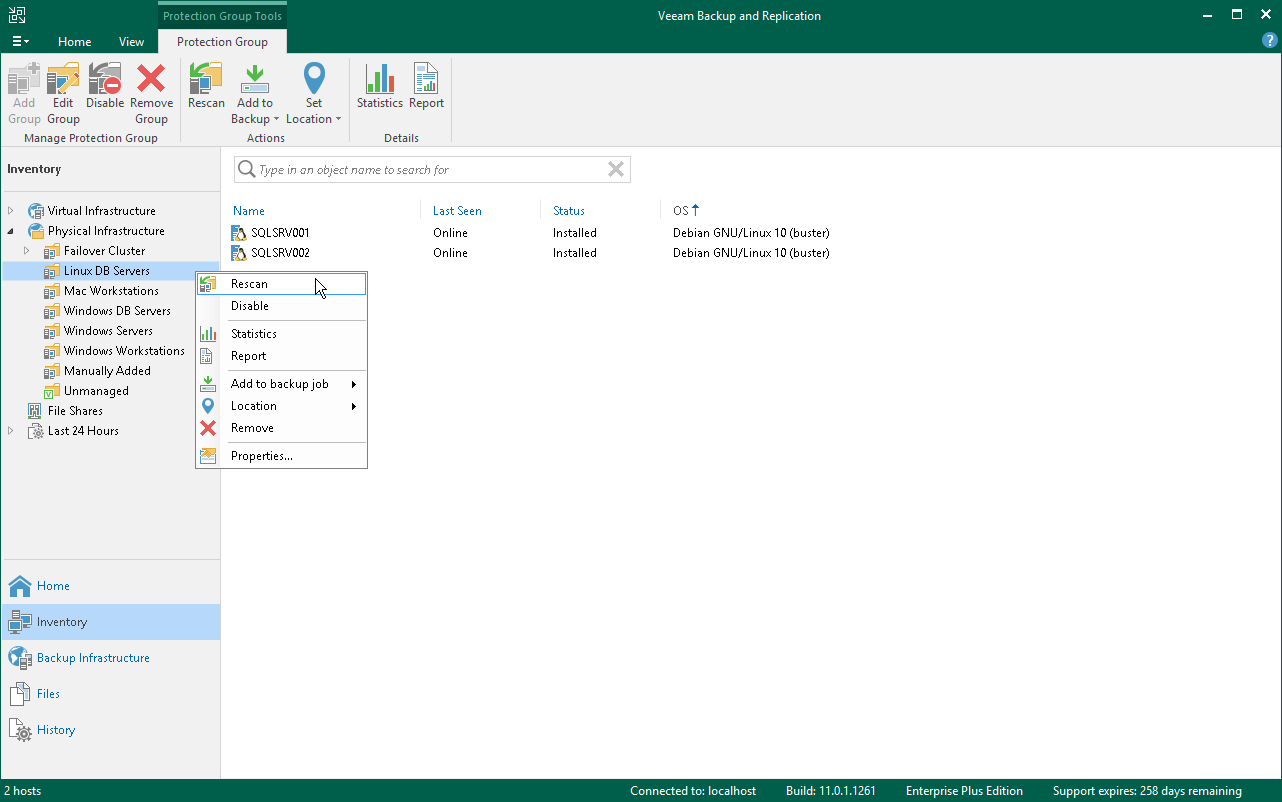 This is an archive version of the document. To get the most up-to-date information, see the current version.
This is an archive version of the document. To get the most up-to-date information, see the current version.Deployment Procedure for Linux Computers
To deploy a hotfix on Linux computers included in the protection group, perform the following steps:
- Obtain a hotfix from Veeam Customer Support or download it from the Veeam software repository.
- Save Veeam Agent for Linux packages to the following folder on the distribution server specified in the protection group settings:
For 32-bit CentOS / RHEL / Oracle Linux / Fedora / openSUSE / SLES
C:\ProgramData\Veeam\Agents\val\x86\rpm |
For 64-bit CentOS / RHEL / Oracle Linux / Fedora / openSUSE / SLES
C:\ProgramData\Veeam\Agents\val\x64\rpm |
For 32-bit Debian / Ubuntu
C:\ProgramData\Veeam\Agents\val\x86\deb |
For 64-bit Debian / Ubuntu
C:\ProgramData\Veeam\Agents\val\x64\deb |
- Replace names of Veeam Agent for Linux package in the index file.
- Open the ValPackageIndex.xml file that is located in the following folder on the distribution server specified in the protection group settings:
C:\ProgramData\Veeam\Agents\val |
- In the ValPackageIndex.xml file, locate packages that you want to update. Replace their names with names of Veeam Agent for Linux packages you saved in step 2. After that, save changes and close the index file. For more detailed explanation, see Example.
- Rescan the protection group:
- Open the Inventory view.
- In the inventory pane, expand the Physical Infrastructure node.
- In the inventory pane, select the necessary protection group and click Rescan on the ribbon or right-click the protection group and select Rescan.
For example, Veeam Software issued a hotfix for Veeam Agent for Linux 5.0.2 for 64-bit RHEL 8 and you want to deploy it on your Veeam Agent computers.
In this scenario, the hotfix consists of the following Veeam Agent packages:
- veeamsnap-5.0.2.XXXX-1.noarch.rpm
- veeam-5.0.2.XXXX-1.el8.x86_64.rpm
- kmod-veeamsnap-5.0.2.XXXX-1.el8.x86_64.rpm
To deploy the hotfix, you need to do the following:
- Obtain all three updated Veeam Agent for Linux packages from Veeam Customer Support or download them from the Veeam software repository.
- Save the packages to the following folder on the distribution server specified in the protection group settings:
C:\ProgramData\Veeam\Agents\val\x64\rpm |
You do not need to delete obsolete Veeam Agent for Linux packages you want to update.
- Edit the index file located in the following folder on the distribution server specified in the protection group settings:
C:\ProgramData\Veeam\Agents\val |
- Open the ValPackageIndex.xml file.
- Locate the packages that you want to update and replace their version and names with version and names of the packages you saved is step 2.
Usually, the packages that are available as a hotfix have a build version that is different from the obsolete packages. In this scenario, obsolete packages have the 5.0.2.4567 build version and the updated packages have the 5.0.2.XXXX build version.
In the example below, replaced package version and names are highlighted in green:
... <Distribution id="RHEL" displayName="Red Hat"> <Version majorVersions="6"> <Packages version="5.0.2.4567" arch="x64"> <driver_noarch value="veeamsnap-5.0.2.4567-1.noarch.rpm"/> <driver_uefi_cert value="veeamsnap-ueficert-5.0.2.4567-1.noarch.rpm"/> <driver_bin value="kmod-veeamsnap-5.0.2.4567-2.6.32_131.0.15.el6.x86_64.rpm"/> <veeam value="veeam-5.0.2.4567-1.el6.x86_64.rpm" /> </Packages> <Packages version="5.0.2.4567" arch="x86"> <driver_noarch value="veeamsnap-5.0.2.4567-1.noarch.rpm"/> <driver_bin value="kmod-veeamsnap-5.0.2.4567-2.6.32_131.0.15.el6.i386.rpm"/> <veeam value="veeam-5.0.2.4567-1.el6.i386.rpm"/> </Packages> </Version> <Version majorVersions="7"> <Packages version="5.0.2.4567" arch="x64"> <driver_noarch value="veeamsnap-5.0.2.4567-1.noarch.rpm"/> <driver_uefi_cert value="veeamsnap-ueficert-5.0.2.4567-1.noarch.rpm"/> <driver_bin value="kmod-veeamsnap-5.0.2.4567-1.el7.x86_64.rpm"/> <veeam value="veeam-5.0.2.4567-1.el7.x86_64.rpm"/> </Packages> </Version> <Version majorVersions="8"> <Packages version="5.0.2.XXXX" arch="x64"> <driver_noarch value="veeamsnap-5.0.2.XXXX-1.noarch.rpm"/> <driver_uefi_cert value="veeamsnap-ueficert-5.0.2.4567-1.noarch.rpm"/> <driver_bin value="kmod-veeamsnap-5.0.2.XXXX-1.el8.x86_64.rpm"/> <veeam value="veeam-5.0.2.XXXX-1.el8.x86_64.rpm"/> </Packages> </Version> </Distribution> .... |
- Save changes and close the index file.
- Rescan the protection group:
- Open the Inventory view.
- In the inventory pane, expand the Physical Infrastructure node.
- In the inventory pane, select the necessary protection group and click Rescan on the ribbon or right-click the protection group and select Rescan.
During the rescan, Veeam Backup & Replication will use updated packages specified in the index file to install Veeam Agent for Linux version with the hotfix on protected computers.
